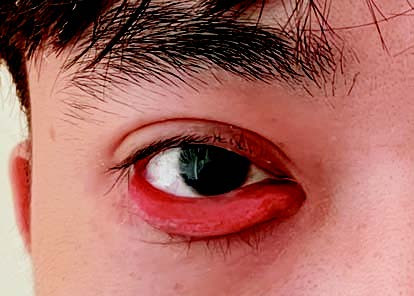Non-infectious blepharitis is associated with various factors, including Meibomian gland dysfunction (MGD), refractive errors, visual fatigue, Sjögren's syndrome, air pollution, exposure to high temperatures, prolonged use of low-quality cosmetics, repetitive eye rubbing, and poor eyelid hygiene.
Clinical Manifestations
Patients often experience symptoms such as itching, pricking sensations, and burning in the eyes. The eyelid margin may appear congested and reddish, with flaky debris attached to the eyelashes and the surface of the eyelid margin. Seborrheic secretion is often observed on the eyelid margin as small, greasy deposits that accumulate at the base of the eyelashes, forming yellow waxy secretions that dry into crusts. Although the eyelid margin is congested, there are no ulcers or pustules. Eyelashes may become prone to falling out, but they typically regenerate. Chronic, unresolved cases may result in thickening of the eyelid margin and rounding of the posterior margin, leading to the inability of the eyelid margin to make proper contact with the eyeball. This can cause tear puncta swelling, eversion, and subsequent tearing.

Figure 1 Appearance of non-infectious blepharitis
The patient's right lower lid shows congested and thickened eyelid margins, with a rounded posterior margin and swollen, everted tear puncta.
Diagnosis
A diagnosis can be made based on the typical clinical presentation, particularly the absence of pustules or ulceration on the eyelid margin.
Treatment
Elimination of Contributing and Irritating Factors
Addressing underlying issues such as refractive errors is important. Concurrent treatment of systemic chronic conditions is necessary if present. Attention to nutrition and physical exercise may help in enhancing overall body resistance.
Eyelid Hygiene
Cleaning of the eyelid margin with normal saline or a 3% boric acid solution is recommended. After removing crusts, antibiotic eye ointments can be applied 2–3 times daily. Once recovery occurs, continuing treatment once daily for at least two weeks is advisable to prevent recurrence.
Surgical Consideration for Chronic, Resolved Cases
Cases with persistent thickening and rounding of the eyelid margin, along with tear puncta swelling and eversion, may require surgical intervention.